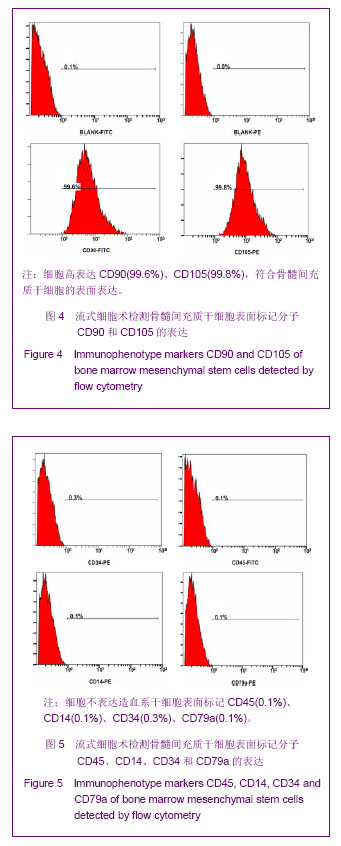| [1] Dominici M, Le Blanc K, Mueller I, et al. Minimal criteria for defining multipotent mesenchymal stromal cells. The International Society for Cellular Therapy position statement. Cytotherapy. 2006;8(4):315-317.[2] Pittenger MF, Mackay AM, Beck SC, et al. Multilineage potential of adult human mesenchymal stem cells. Science 1999, 284(5411):143-147. [3] Spees JL, Gregory CA, Singh H, et al. Internalized antigens must be removed to prepare hypoimmunogenic mesenchymal stem cells for cell and gene therapy. Mol Ther. 2004;9(5): 747-756. [4] Sarah S, Tamara V, Peggy P, et al. Sequential Exposure to Cytokines Reflecting Embryogenesis: The Key for in vitro Differentiation of Adult Bone Marrow Stem Cells into Functional Hepatocyte-like Cells. Toxicological Science. 2006;94(2):330-341.[5] Dong XJ, Zhang H, Pan RL, et al. Identification of cytokines involved in hepatic differentiation of mBM-MSCs under liver- injury conditions.World J Gastroenterol. 2010;16(26):3267-3278.[6] Huang YH, Shi MN, Zheng WD, et al. Therapeutic effect of interleukin-10 on CCl4-induced hepatic fibrosis in rats. World J Gastroenterol. 2006;12(9):1386-1391.[7] Weng HL, Wang BE, Jia JD, et al. Effect of interferon-γ on hepatic fibrosis in chronic hepatitis B virus infection:a randomized controlled study. Clin Gastroenterol Hepatol. 2005;3(8):819-828.[8] Petersen BE, Bowen WC, Patrene KD, et al. Bone marrow as a potential source of hepatic oval cells. Science. 1999; 284 (5417):1168-1170. [9] Am Esch JS 2nd, Knoefel WT, Klein M, et al. Portal application of autologous CD133+ bone marrow cells to the liver: a novel concept to support hepatic regeneration. Stem Cells. 2005;23(4):463-470.[10] Feng Z, Li C, Jiao S,et al.In vitro differentiation of rat bone marrow mesenchymal stem cells into hepatocytes. Hepatogastroenterology. 2011;58(112):2081-2086.[11] 吴晓玲,曾维政,蒋明德,等.红景天甙对肝纤维化大鼠肝组织ROCK表达的影响[J].世界华人消化杂志,2009,8:765-769.[12] 张华,戴立里,曾维政,等.红景天甙对大鼠肝组织TGF-β1/Smads 信号通路的作用[J].重庆医科大学学报,2011, 36(6):699-703.[13] 杨斌,曾维政,蒋明德,等.红景天甙对乙醛刺激的大鼠肝星状细胞中Wnt 信号通路的影响及其意义探讨[J].重庆医科大学学报, 2010,35(11):1630-1633.[14] 荣黎,戴立里,曾维政,等.红景天甙对拟高原缺氧大鼠肝损伤的保护作用[J].中国组织工程研究与临床康复,2010,14(31): 5813- 5817.[15] Ouyang JF, Lou J, Yan C, et al. In-vitro promoted differentiation of mesenchymal stem cells towards hepatocytes induced by salidroside. J Pharm Pharmacol. 2010;62(4):530-538.[16] 邹毅清,蔡志扬,李小宝,等.红景天苷预处理对大鼠全脑缺血再灌注后炎症反应的影响[J].现代中西医结合杂志,2011,22(3): 253-255.[17] 高琨,胡美琴,祁洪刚,等.红景天苷对大鼠肾脏缺血再灌注损伤的预防保护时限[J].吉林大学学报(医学版),2012,38(4):687-691.[18] 黄晓颖,樊荣,蔡学定,等.腺苷A2a受体在红景天苷调节大鼠低氧性肺动脉高压中的作用[J].中国病理生理杂志,2012,28(12): 2135-2140.[19] Colter DC,Class R, Digirolamo CM,et al.Rapid expansion of recycling stem cells in cultures of plastic-adherent cells from human bone marrow.Proc Natl Acad Sci USA. 2000;97(7): 3213-3218.[20] Tonraeau T,Lagneaux L,Edjeneffe M,et al.Isolation of BMSCs by plastic adhesion or negative selection:phenotype,proliferation kinetics and differentiation potential. Cytotherapy. 2004;6(4):372-379.[21] Gindraux F,Selmani Z,Obert L,et al.Human and rodent bone marrow mesenchymal stem cells that express primitive stem cell markers can be directily enriched by using the CD49a molecule.Cell Tissue Res.2007;327(3):471-483.[22] Lee BK, Choi SJ, Mack D, et al. Isolation of mesenchymal stem cells from the mandibular marrow aspirates. Oral Surg Oral Med Oral Pathol Oral Radiol Endod. 2011c;112(6): e86-93. [23] Dominici M, Le Blanc K, Mueller I, et al. Minimal criteria for defining multipotent mesenchymal stromal cells. The International Society for Cellular Therapy position statement. Cytotherapy. 2006;8(4):315-317.[24] Dong XJ, Zhang H, Pan RL, et al. Identification of cytokines involved in hepatic differentiation of mBM-MSCs under liver-injury conditions.World J Gastroenterol. 2010;16(26): 3267-3278.[25] Hu JJ, Sun C, Lan L, et al. Therapeutic effect of transplanting β2m-/Thy1+ bone marrow-derived hepatocyte stem cells transduced with lentiviral-mediated HGF gene into CCl4-injured rats. J Gene Med. 2010;12(3):244-254.[26] 哈小琴,董芳,吕同德.肝细胞生长因子基因对骨髓间充质干细胞的修饰及活性观察[J].中国修复重建外科杂志,2010,24(5): 613-617.[27] Forte G, Minieri M, Cossa P, et al. Hepatocyte growth factor effects on mesenchymal cells: Proliferation, migration, and differentiation. Stem Cells. 2006;24(1):23-33.[28] Schwartz RE, Reyes M, Koodie L, et al. Multipotent adult progenitor cells from bone marrow differentiate into functional hepatocyte-like cells. J Clin Invest. 2002;109(10):1291-1302.[29] Avital I,Inderbitzin D,Aoki T,et al.Isolation, characterization, and transplantation of bone marrow-derived hepatocyte stem cells. Biochem Biophys Res Commun. 2001;288(1):156-164.[30] 钟晓琳,万居易,王忠琼,等.淤胆血清及肝细胞生长因子体外诱导BMSCs向肝细胞分化[J].中国修复重建外科杂志,2010,24(3): 344-349. |







.jpg)